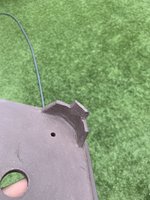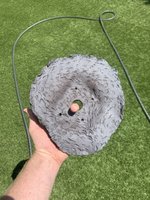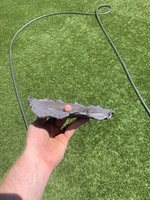Do you have a site? I'd love to see your pots!No argument from me there. That is ice cubes 101. But the colder the zone the more likely a freeze & thaw cycle.
.... except when they are not. Many of the Chinese bonsai pots, though constructed to near mathematical perfection, and fired to exactitude will not hold up to our cycle based solely on the clay body itself. I have used a few for target practice. Also true for many hand made planters built by some our finest local professional potters who's usual fair is not planters but platters, and who treat the absorption factors with little regard.
There is really not a certifiable point of comparison here, our climates are apples and oranges. My pottery is made to withstand my climate and harsher climates, and absorption rate is an important factor. It doesn't matter that many of my pots have ended up in California, as some of them also end up in New England.
Good discussion.
You are using an out of date browser. It may not display this or other websites correctly.
You should upgrade or use an alternative browser.
You should upgrade or use an alternative browser.
Diving into pottery
- Thread starter mwar15
- Start date
penumbra
Imperial Masterpiece
No, I am getting too old to mess with keeping a site up and I don't want to get into more than I can handle. I have listed and sold pots here and will list more next week. Check archives for stone look pots or stone age pots. This is what I enjoy working on. I throw too but don't currently have any of those .... could be a couple weeks, maybe three.Do you have a site? I'd love to see your pots!
Pitoon
Imperial Masterpiece
I find it interesting that we all make pots, but each of us is on own avenue.
mwar15
Omono
I wedge before I start rolling.
I will use up the rest of the dark clay and go back to a lighter clay.
I took the last pot to the kiln Thursday night. I am not using any supports under it. I’ll update how it turns out
I will use up the rest of the dark clay and go back to a lighter clay.
I took the last pot to the kiln Thursday night. I am not using any supports under it. I’ll update how it turns out
penumbra
Imperial Masterpiece
Yeh, inquiring minds and all. I am hoping for the best.I took the last pot to the kiln Thursday night. I am not using any supports under it. I’ll update how it turns out
mwar15
Omono
I picked up another pot today and talked with the manager. I think it’s a combination of a lot of things that are causing the cracks. He’s using shelves that are high end he said to help with glaze drips and not sticking and cleanup. They’re very rough and I think my pots are just sticking to them because he doesn’t put any sort of wash on them or sand to help the pots move as they are fired. He said he would use different shelves for my pots to help prevent that if that is indeed what is happening. I picked up a different clay I’m going to try that and see how it works.






TinyArt
Chumono
Good looking pot -- glad it's still functional, cracks hidden
penumbra
Imperial Masterpiece
Fill those cracks with epoxy and use it on your own bench. I just potted a large bonsai pot that cracked apart on me about 20+ years ago. It was fixed with epoxy and has been stored outside for all these years.
mwar15
Omono
That’s what I usually doFill those cracks with epoxy and use it on your own bench. I just potted a large bonsai pot that cracked apart on me about 20+ years ago. It was fixed with epoxy and has been stored outside for all these years.
sorce
Nonsense Rascal
I picked up another pot today and talked with the manager. I think it’s a combination of a lot of things that are causing the cracks. He’s using shelves that are high end he said to help with glaze drips and not sticking and cleanup. They’re very rough and I think my pots are just sticking to them because he doesn’t put any sort of wash on them or sand to help the pots move as they are fired. He said he would use different shelves for my pots to help prevent that if that is indeed what is happening. I picked up a different clay I’m going to try that and see how it works.
View attachment 383682View attachment 383683View attachment 383684
Those are definitely shrink drag cracks.
All the same "Bonsai pots are like no other pots" things apply to those shelves too.
Because those shelves stay flatter then others, using them with sand underfoot, or better a slab of the same clay underneath at the same state of fired, will be cureful.
Unless the new clay shrinks by 5 or 6% less, it likely won't prove consistently better.
That's a nice one!
Sorce
mwar15
Omono
That’s why we are using a shelf with a wash on it for my pots moving forward to prevent it.Those are definitely shrink drag cracks.
All the same "Bonsai pots are like no other pots" things apply to those shelves too.
Because those shelves stay flatter then others, using them with sand underfoot, or better a slab of the same clay underneath at the same state of fired, will be cureful.
Unless the new clay shrinks by 5 or 6% less, it likely won't prove consistently better.
That's a nice one!
Sorce
thanks
sorce
Nonsense Rascal
That’s why we are using a shelf with a wash on it for my pots moving forward to prevent it.
thanks
Kiln wash isn't an anti drag stick device.
Sorce
penumbra
Imperial Masterpiece
I do nearly all of my bisque firing on naked shelves, no kiln wash at all.
My shelves in my glaze kiln all have kiln wash which is reapplied after 6 to 8 firings usually.
My shelves in my glaze kiln all have kiln wash which is reapplied after 6 to 8 firings usually.
mwar15
Omono
Whatever he puts on the kiln shelf, he said in the glaze kiln he switch and stopped using the washed shelves and my pots started cracking. So he was more than willing to use the older washed shelves for me.Kiln wash isn't an anti drag stick device.
Sorce
mwar15
Omono
Pitoon
Imperial Masterpiece
My eyes looked at the pot which is nice then focused on the grass.....is that real grass?
mwar15
Omono
No, turfMy eyes looked at the pot which is nice then focused on the grass.....is that real grass?
mwar15
Omono
Pitoon
Imperial Masterpiece
That glaze came out really nice.
rockm
Spuds Moyogi
The construction and glaze on this are excellent. Nicely done!One I made a while ago, can finally post photos of itView attachment 386555View attachment 386556View attachment 386557
An observation, however--I'm not a potter, but I use A LOT of pots. Square pots are mostly useless for bonsai, or at least very hard to match with trees. Equilateral sides tend to cancel out the visual fore shortening that adds to a tree's image illusion. Shorter sides, coupled with longer front and back (a rectangle) enforces a bit of visual forced perspective. IF this pot had sides that were half or a third shorter than the back and front, it would work well with any number of trees.
Foreshortening is a critical artistic technique for bonsai. It's used in making trees--a wide trunk base, that tapers dramatically to a much narrower top--makes a tree look powerful and tall. That's because it tricks the eye into seeing a larger image in a smaller space. Such foreshortening in a bonsai pot, shorter sides, wider front and back, forces the eye to think its seeing more depth in the composition than there really is....







